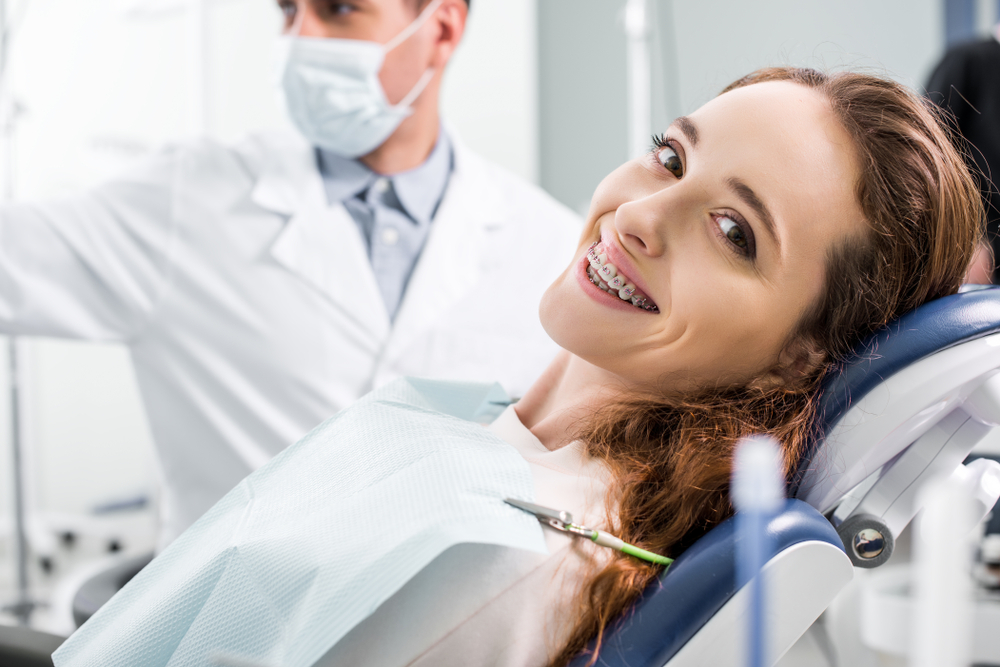When people are considering getting braces to correct their crooked teeth, the benefits of undergoing orthodontic treatment are clear—a beautiful smile and a healthy, well-aligned bite in the future. Some may still hesitate, though, because before they reach that day, there’s the reality of wearing braces for twelve to eighteen months or more to deal with. While it’s more common for children and teens to feel self-conscious about possibly being teased for having braces, adult patients also worry about how others will react, especially when maintaining a professional appearance is important.
No matter what your age, it’s natural to experience some anxiety about the psychological and social effects of wearing braces. However, it’s possible to overcome those issues during treatment with the right knowledge and attitude. Here’s what you should know.
How Braces Affect Your Mental Health
Thinking of braces may bring immediate associations with embarrassment or lower self-esteem, but research tells a different story. A 2018 study titled “The Effect of Orthodontic Intervention on Mental Health and Body Image” sought to determine the relationship between orthodontics, mental health, and body image by analyzing the experience of 110 orthodontic patients aged 14 and above. Their results showed that orthodontic treatment improved mental health, reducing physical, anxiety, sleep disorder, and depressive symptoms while improving social functioning. In addition, the treatment improved patients’ attitudes toward body image.
This outcome may not be a surprise for adult patients eager to exchange long-standing problems with crowded or misaligned teeth for an even, comfortable smile. For younger patients who are more focused on the immediate prospect of what braces will look like, though, gaining some perspective on the long-term good can help them deal with the short-term inconvenience of undergoing treatment.
Modern Orthodontic Care
Knowing what to expect with any type of orthodontic care is key to having a positive attitude. This is especially true when we’re dispelling myths based on what braces used to be like. Nowadays, traditional brackets are smaller than they used to be, so though they’re still visible, they don’t have the same “metal mouth” look they used to decades ago. It’s also possible to get clear brackets, which allow the natural tooth color to show through for a less conspicuous appearance. In fact, orthodontists may not even need to use traditional braces to treat underbites, overbites, and crossbites, or gappy, crowded, or crooked teeth.
For example, Invisalign is a popular option with both adults and teens wanting a discreet option for straightening their teeth. While braces guide teeth into proper alignment with brackets affixed to the teeth and an archwire that applies tension to direct tooth movement, Invisalign uses a series of clear aligner trays that gently push the teeth into new positions. The trays are practically invisible when worn, eliminating many patient concerns regarding how noticeable their treatment will be to those around them.
Of course, Invisalign requires a high degree of patient compliance to achieve results in a similar time frame to braces, as the trays must be worn 20 to 22 hours per day. While parents may be unsure if their children will keep up with this routine, we’ve found that choosing a treatment method the patient is comfortable with can be very motivating! It’s worth looking at all your options before deciding what makes the most sense in your case.
Adults may also want to consider a third option that gives them the convenience of a fixed appliance but is even less noticeable than Invisalign—InBrace. This lingual brace system works by attaching brackets to the back of the teeth rather than the front, so there’s literally nothing to be seen as the patented Smart wire steadily works to align your teeth.
A Means to an End
Young patients may be the most apprehensive about getting braces because they fear getting teased, but also because they know less about how braces work and why getting them is important. Explaining what to expect with treatment and the benefits it will have for both the health and appearance of their teeth can go a long way to dispelling fears. For any patient, though, it helps to consider that orthodontic treatment is a tool to reach the goal of having a beautiful, healthy smile. Any temporary discomfort or inconvenience is more than offset by the lifelong benefits achieved.
At B Orthodontics, we use the latest techniques and technology to give our patients the utmost in orthodontic care. More importantly, though, we’re here to answer any questions you have to ensure that you know your options and are comfortable and confident throughout your treatment. If you’re ready to take the first step toward straight teeth and a healthy bite, schedule your initial consultation by contacting us here today.











